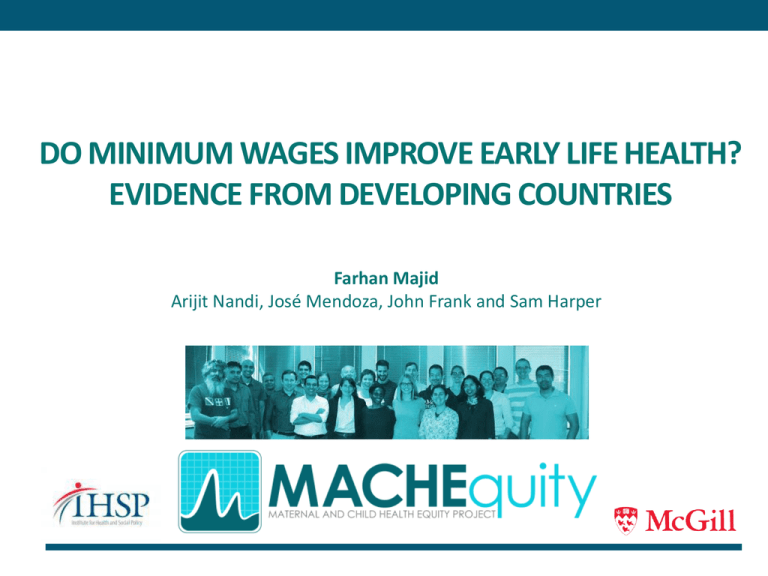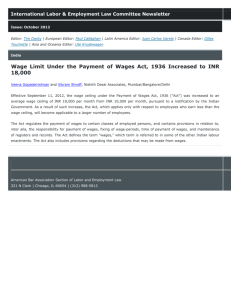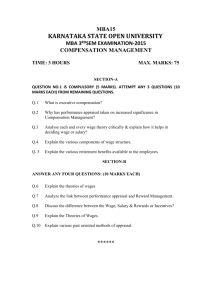Do Minimum Wages Improve Early Life Health?
advertisement

DO MINIMUM WAGES IMPROVE EARLY LIFE HEALTH? EVIDENCE FROM DEVELOPING COUNTRIES Farhan Majid Arijit Nandi, José Mendoza, John Frank and Sam Harper 2 Motivation Early life environmental conditions play a critical role in child health and well being over the life-course Famines and pandemics during early childhood have been studied as natural experiments (Almond and Currie, 2011) Little is understood about the causal effects of mild, commonly observed and policy relevant shocks Labor market institutions, specifically income protection legislation, may shape incentives and opportunities for investing by parents, and may subsequently impact child life health outcomes Do minimum wages (MW) improve early life health? 3 Background on Minimum Wages Economists have been studying the impact of minimum wages, especially on employment, for more than six decades (Stigler, 1946; Card and Krueger, 1994) There is evidence that a moderate rise in the minimum wage can increase the earnings of low-income workers without causing job losses However, empirical findings have also shown that higher minimum wages lead to lower employment as costs of production increase and firms respond by laying off workers (Neumark and Wascher, 2008) Betcherman (2012) argues that in general, minimum wage laws lead to modest negative or insignificant effects on aggregate employment, with a few studies finding positive effects When negative employment effects are observed, it is the younger and lesser skilled groups who tend to be affected 4 Minimum Wages and Child Health Minimum wages influence the distribution of household socio- economic resources and hence parental investments in child health. If wages increase, families may increase health services utilization and may engage in other salutary behaviors. On the other hand, the effects of minimum wages may also vary according to household socioeconomic status (SES) For instance, as wages increase, poorer mothers may be more likely to spend more time in the labor market at the expense of care-giving activities. Ultimately, whether minimum wage laws lead to improvements or deterioration in child health, through changes in parental economic conditions, is an open empirical question. 5 Data Minimum Wage Policy Database Constructed by McGill University’s Maternal and Child Health Equity Program (MACHEquity) in collaboration with UCLA’s WORLD Policy Analysis Center Data contains country-year observations of minimum wage levels, as set by policy between 1999 and 2013. We used PPP conversion and inflation factors from the World Bank Development Indicators (WDI) to create a minimum wage series in PPP constant 2011 US dollars. Key Variable: Log Minimum Wage 6 Data The Standard Demographic and Health Surveys (DHS) Nationally representative household surveys from 57 countries in Asia, Africa, Europe and the Americas spanning more than a decade between 2000-2013 Health and sociodemographic information on women of reproductive age (15–49 years), men (usually aged 15–54 or 15–59), and children ever born (Corsi et al. 2012) Data on individual birth history as well as parental SES Dependent Variable: Height for age z scores for children 05 years old 7 Empirical Strategy We exploit arguably exogenous timing of changes in minimum wages with the timing of births. Children born in periods of lower minimum wages, within the same country, serve as controls for children born during periods of higher minimum wage Identifying assumption: Mothers don’t time their births. Control for wide range of parental SES measures as well as unobservables (explore mother fixed effects model) 8 Empirical Strategy Yimct =α+β1 lo𝑔MWct+β2Ximct +g(c,t)+Uimct (1) Yimct : set of outcomes of interest for child i born in year t, belonging to mother m in country c Ximct: is a vector containing child, parental, household and country level characteristics g(c,t): country fixed effects and time trends Log GDP per capital is also controlled to account for changes in aggregate economic conditions 9 Minimum Wages Lower HAZ Scores, For Females in Particular 0.15 0.1 0.05 0 Overall -0.05 Female Male Point estimates Upper 95% CL -0.1 -0.15 -0.2 -0.25 -0.3 Lower 95% CL 10 Minimum Wage Effects by Mother’s Age and SES 0.05 0 -0.05 -0.1 Prime Aged Mother Married Mother Less Educated Mother Point estimates Upper 95% CL -0.15 -0.2 -0.25 -0.3 Lower 95% CL 11 Minimum Wage Effects by Household Wealth 0.4 0.2 0 Poorest -0.2 Median Income Point estimates Upper 95% CL Lower 95% CL -0.4 -0.6 -0.8 12 Minimum Wage Effects by Baseline GDP per capita 0.3 0.2 0.1 Point estimates 0 Poorest Counrty -0.1 -0.2 -0.3 -0.4 Richer Country Upper 95% CL Lower 95% CL 13 Minimum Wage Effects by Region 0.4 0.2 0 SSA Latin A. South Asia -0.2 Point estimates -0.4 Upper 95% CL Lower 95% CL -0.6 -0.8 -1 -1.2 14 Minimum Wage Effects on Maternal Employment 0.08 0.06 0.04 0.02 Point estimates Upper 95% CL Lower 95% CL 0 Employed -0.02 -0.04 -0.06 Employed- Poor Country Employed- Rich Country 15 Minimum Wage Effects by Parent’s Occupation 0.4 0.3 0.2 0.1 0 Sales- Mother -0.1 -0.2 -0.3 -0.4 -0.5 -0.6 Sales-Father Manual Work Mother Manual Work Father Point estimates Upper 95% CL Lower 95% CL 16 Summary This is the first paper to analyze the causal relation between minimum wages and early life health of children in low and middleincome countries We exploit plausibly exogenous variation in minimum wages with respect to timing of births of children born to parents who were affected by these law, using data from 49 countries between 1999 and 2012. We focus on important measure of child nutrition- height-for age z scores for 0-5 year olds. Our results do not support the hypothesis that minimum wage laws in the developing world generally improve child health Overall, a one percent increase in minimum wages lead to a 0.001 standard deviation decrease in HAZ scores (95% CI= -0.002, 0.000). 17 Summary: We find that effects of minimum wage laws are very heterogeneous: Losers: There is some evidence of sex bias in parental response to minimum wage shocks, as witnessed by more adverse effects on girls Most adverse effects are for children of parents in their prime age, parents who are least educated, and families in the lowest wealth quintile. And among those who work, those working in less skilled occupations (manual work) have the most adverse effects. We find the largest effects in the poorest countries and in the South Asian region. Winners: Those residing in Latin America and those working in sales (a relatively more skilled occupation) actually register positive effects. 18 Future Work Given that this topic has not been studied much before, we think of this paper as scratching the surface on an important yet underresearched topic. Given that we find much heterogeneity in our results, we think there is a need for country and occupation specific studies which can explore not only different outcomes such as infant mortality rates, but also explore the role of parental investments in shaping these effects. 19 Extras: Minimum Wage Effects Employment Through Affecting Labor Demand and Labor Supply 20 Extras: Minimum Wage Effects Employment and Earnings









